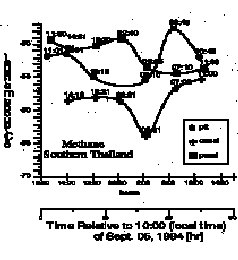
The observations concerned methane from wetlands in Southern Thailand. Diurnal variations in the 13C/12C ratio in bubble methane (Jêdrysek, 1995) formed in shallow-water sediments were observed at a pit (ca. 50 m2, 2 m deep, sulphate-rich artificial pond), a pond (ca. 0.1 km2, rich in submerged and emergent plants), and a canal (isolated from the ground by an impermeable cement cover, ca. 50 cm deep and 1 m wide). Sampling was made on 5 and 6 September 1994. Vertical distribution of isotope composition of methane in sediments (Jêdrysek et al., 1994) was observed in To Daeng tropical forest sediments.
The isotope data show that *13C of methane was the lowest in the night and the highest in the morning, ranging from -64 to -46” (Fig. 1). Smaller values were supposedly resulted from an enhanced activity of the CO2-reducing pathway of methanogenesis. Higher values, on the other hand, were presumably due to reduction of CO2 pool size which should have increased the relative contribution of the acetic acid pathway. Also, primary production that increased daytime should have consumed isotopically lighter CO2 leaving behind heavier CO2 in the residual CO2 pool. The canal methane showed low *13C, presumably due to low activity in the primary production. The pond methane showed relatively small diurnal variation, presumably because the light penetration into water was limited by both high turbidity and abundant macrophytes. This could be the reason of the significant shift in phase in the minimal *13C value from night to early morning and the maximal *13C value from sunset time to early night. The pit methane showed relatively high *13C, possibly due to bacterial oxidation of methane, especially in the very end of the night.
In the freshwater To Daeng sediments, visually judged methane production decreased with increasing depth in sediments and gradually ceased at a depth of about 80cm. Likewise, gradual decrease of *13C suggest that the CO2-H2 pathway become more important with increasing depth in sediments, and methanogenesis via acetic acid fermentation decreased with increasing depth in sediments.
Jêdrysek, M.O., Geochim. Cosmochim. Acta 59, 557-561 (1995).
Jêdrysek, M.O., Halas, St., Wada, E., Sokolowski, K., Filus, M.St., Takai, Y., & Radwan, S., In Extended Abstracts, (Jêdrysek, M.O., ed.), Isotope Workshop II, International Isotope Society and University of Wroclaw, pp. 69-73 (1994).
Fig. 1.